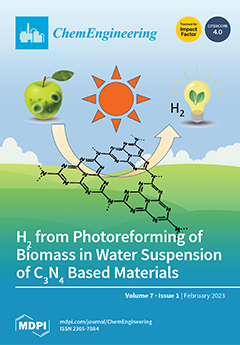Five alkali-activated analcime (ANA) sorbents (ANA-MK 1, ANA 2, ANA 3, ANA-MK 4, and ANA-MK 5) were developed for ammonium (NH
4+) ion removal. Acid treatment and calcination were used as pre-treatments for analcime, and metakaolin (MK) was used as a
[...] Read more.
Five alkali-activated analcime (ANA) sorbents (ANA-MK 1, ANA 2, ANA 3, ANA-MK 4, and ANA-MK 5) were developed for ammonium (NH
4+) ion removal. Acid treatment and calcination were used as pre-treatments for analcime, and metakaolin (MK) was used as a blending agent in three sorbents. Sorption experiments were performed to evaluate the effects of sorbent dosage (1–20 g L
−1), initial NH
4+ ion concentration (5–1000 g L
−1), and contact time (1 min–24 h). ANA-MK 1, ANA 2, and ANA-MK 4 were the most efficient sorbents for NH
4+ ion removal, with a maximum experimental sorption uptake of 29.79, 26.00, and 22.24 mg g
−1, respectively. ANA 3 and ANA-MK 5 demonstrated lower sorption capacities at 7.18 and 12.65 mg g
−1, respectively. The results for the sorption of NH
4+ ions onto the alkali-activated analcime surfaces were modeled using several isotherms. The Langmuir, Freundlich, Sips, and Bi-Langmuir isotherms were the best isotherm models to represent the studied systems. The results of the kinetic studies showed the maximum NH
4+ ion removal percentage of the sorbents was ~80%, except for ANA-MK 5, which had a ~70% removal. Moreover, the pseudo-first-order, pseudo-second-order, and Elovich models were applied to the experimental data. The results showed that the sorption process for ANA-MK 1, ANA 2, ANA 3, and ANA-MK 4 followed the Elovich model, whereas the pseudo-second-order model provided the best correlation for ANA-MK 5.
Full article





